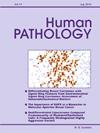在韩国人群中使用CYP11B2(醛固酮合成酶)免疫组织化学阳性的最佳临界值和修改的组织学标准对单侧原发性醛固酮增多症进行亚分类。
IF 2.6
2区 医学
Q2 PATHOLOGY
引用次数: 0
摘要
原发性醛固酮增多症(hisaldo)的组织病理学一致表明,CYP11B2(醛固酮合成酶)免疫染色诊断原发性醛固酮增多症(PA)的必要性。然而,CYP11B2免疫染色阳性解释的合适阈值尚未确定。因此,我们旨在将PA的亚分类与术后结果联系起来,以确定83例单侧PA患者CYP11B2免疫染色的最佳临界值。最初的73例经典PA患者使用1%的临界值显示,经典PA和非经典PA的临床失败率相似(9.7%)(11.1%,p > 0.999)。经典PA患者的生化失败率(4.4%)低于非经典PA患者(20.0%,p = 0.120)。在建立新的30% CYP11B2免疫染色临界值后,83例患者中有68例(81.9%)被重新分类为经典PA。尽管无统计学意义,但经典PA患者临床和生化治疗成功率均低于非经典PA患者(分别为8.8%和4.7%)(14.3%,p = 0.158;14.3%, p = 0.218)。最后,使用1%和30%的临界值,根据单一醛固酮产生病变的存在,应用改进的组织学亚分类。69例(1% cut- cut)和64例(30% cut- cut- cut)被细分为改良经典PA。然而,在临床和生化成功方面,使用这两个临界值,他们并不优于非经典同行。总之,临床和生化结果不能通过1%或30%的临界值和修改的组织学标准成功预测。需要在更大的患者群体中进行进一步的验证研究。本文章由计算机程序翻译,如有差异,请以英文原文为准。
Subclassification of unilateral primary aldosteronism using an optimal cut-off value for positive CYP11B2 (aldosterone synthase) immunohistochemistry and modified histologic criteria in the Korean population
The histopathology of primary aldosteronism (HISTALDO) consensus indicates the necessity of CYP11B2 (aldosterone synthase) immunostaining in diagnosing primary aldosteronism (PA). However, proper threshold for positive interpretation of CYP11B2 immunostaining is yet to be established. Therefore, we aimed to correlate the subclassification of PA and postsurgical outcomes to define an optimal cut-off value for CYP11B2 immunostaining in 83 unilateral PA patients. Initial 73 classical PA patients using a 1 % cut-off value revealed a similar rate of absence of clinical success between classical PA (9.7 %) and non-classical PA (11.1 %, p > 0.999). The absence of biochemical success was lower in classical PA (4.4 %) than non-classical PA (20.0 %, p = 0.120). After establishing new 30 % cut-off value for CYP11B2 immunostaining, 68 of 83 (81.9 %) patients were re-classified as classical PA. Despite statistical insignificance, the absence of both clinical and biochemical success was lower in classical PA (8.8 % and 4.7 %, respectively) than non-classical PA (14.3 %, p = 0.158; 14.3 %, p = 0.218, respectively). Finally, a modified histologic subclassification was applied according to the presence of single aldosterone producing lesion using both 1 % and 30 % cut-off values. 69 (1 % cut-off) and 64 (30 % cut-off) cases were subclassified as modified classical PA. However, they were not superior to their non-classical counterparts in terms of both clinical and biochemical success using both cut-off values. In summary, the clinical and biochemical outcomes were not successfully predicted by either 1 % or 30 % cut-off values and modified histologic criteria. Further validation study on a larger patient cohort is needed.
求助全文
通过发布文献求助,成功后即可免费获取论文全文。
去求助
来源期刊

Human pathology
医学-病理学
CiteScore
5.30
自引率
6.10%
发文量
206
审稿时长
21 days
期刊介绍:
Human Pathology is designed to bring information of clinicopathologic significance to human disease to the laboratory and clinical physician. It presents information drawn from morphologic and clinical laboratory studies with direct relevance to the understanding of human diseases. Papers published concern morphologic and clinicopathologic observations, reviews of diseases, analyses of problems in pathology, significant collections of case material and advances in concepts or techniques of value in the analysis and diagnosis of disease. Theoretical and experimental pathology and molecular biology pertinent to human disease are included. This critical journal is well illustrated with exceptional reproductions of photomicrographs and microscopic anatomy.
 求助内容:
求助内容: 应助结果提醒方式:
应助结果提醒方式:


